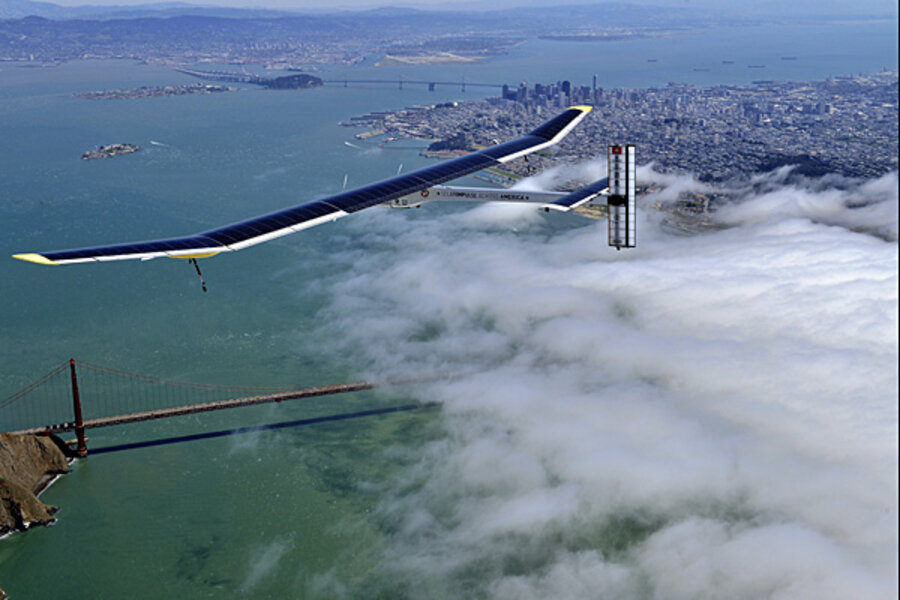Solar Impulse departs for first sun-powered flight across US
Loading...
A solar-powered plane took off from an airfield near San Francisco early Friday morning, intent upon completing the first cross-country flight relying only on the power of the sun.
If you're picturing photovoltaics glistening on jumbo-jet wings, some curbing of enthusiasm is in order. Friday's landmark event is less a peek into the future of commercial flight than it is a dramatic endorsement of clean-energy technology.
"It is the first and only airplane that can fly day and night on solar power without any fuel," said Bertrand Piccard, a pilot of the so-called Solar Impulse, in a midflight interview via radio with CBS 5 News Phoenix.
"It is possible because all the technologies we use are really energy-efficient technologies," Mr. Piccard added, his voice crackling through static as he soared 13,000 feet over Fresno, Calif., en route to Phoenix. "We want to promote these technologies."
Twelve thousand photovoltaic cells make up the 747-sized wingspan of the Solar Impulse. Those cells convert light into electricity, which drives the propellers.
Excess energy is stored on board in batteries, allowing the plane to run at night.
The craft weighs less than an SUV, is unheated and unpressurized. It holds one pilot at a time who wears an oxygen mask and a parachute. It can't fly much faster than 65 miles per hour and is very susceptible to high winds and storms. And it will make stops along the way. The cross-country trip will take more than a month.
"Admittedly, it’s a long way from being commercial," said John Petersen, chairman of the Lindbergh Foundation, a nonprofit that addresses aviation-environmental issues based in Anoka, Minn. "But it does start to say that with this technology, it’s possible to fly even all around the world. That’s an amazing, significant kind of thing."
The symbolic flight could serve as inspiration for pilots and engineers working to 'green' air travel through breakthroughs in electrical systems, lightweight materials, and reduced drag, Mr. Petersen added in a phone interview.
Despite the innovations, it's possible solar power will never be a viable option for mainstream passenger air travel.
"For a solar power airplane to be commercially viable it has to be fast," Bob van der Linden, chairman of the aeronautics division at the Smithsonian National Air and Space Museum, said in a telephone interview. "That means jet power, not solar power."
The Solar Impulse's engines put out 10 horsepower, about as much power as the Wright brothers' first planes. It can fly at only a little better than half the speed that Charles Lindbergh did when he made the first solo nonstop flight across the Atlantic Ocean in 1927. That historic trip paved the way for modern-day commercial air travel. Solar planes may only come to serve limited purposes, Mr. van der Linden said.
Still, Piccard and André Borschberg, his fellow Solar Impulse pilot and cofounder, can't help but invite comparisons to the legendary pilots who set out on pioneering trips that were as much about the human spirit as they were about mechanical innovation.
"There are far fewer frontiers – in the way we were all raised to think about them – that exist on the planet today," Mr. Petersen said. "[Solar Impulse] just reverberates through the system and holds up to young people the possibility of doing things they probably wouldn’t have thought were possible."
The solar plane will make stops in Phoenix, Dallas, St. Louis, Washington, and New York and is expected to conclude its transcontinental trip next month. The team plans to make the first sun-powered flight around the world in 2015.






